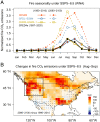Tripling of western US particulate pollution from wildfires in a warming climate
- PMID: 35344431
- PMCID: PMC9168465
- DOI: 10.1073/pnas.2111372119
Tripling of western US particulate pollution from wildfires in a warming climate
Abstract
SignificanceRecord-setting fires in the western United States over the last decade caused severe air pollution, loss of human life, and property damage. Enhanced drought and increased biomass in a warmer climate may fuel larger and more frequent wildfires in the coming decades. Applying an empirical statistical model to fires projected by Earth System Models including climate-ecosystem-socioeconomic interactions, we show that fine particulate pollution over the US Pacific Northwest could double to triple during late summer to fall by the late 21st century under intermediate- and low-mitigation scenarios. The historic fires and resulting pollution extremes of 2017-2020 could occur every 3 to 5 y under 21st-century climate change, posing challenges for air quality management and threatening public health.
Keywords: Earth System Models; air quality; climate warming; drought; fires.
Conflict of interest statement
The authors declare no competing interest.
Figures







References
-
- US Environmental Protection Agency, Data from the 2017 National Emissions Inventory (2017). https://www.epa.gov/air-emissions-inventories/2017-national-emissions-in.... Accessed 20 March 2021.
-
- Bowman D. M. J. S., et al. , Vegetation fires in the Anthropocene. Nat. Rev. Earth Environ. 1, 500–515 (2020).
-
- Schill G. P., et al. , Widespread biomass burning smoke throughout the remote troposphere. Nat. Geosci. 13, 422–427 (2020).
MeSH terms
Substances
LinkOut - more resources
Full Text Sources
Medical

